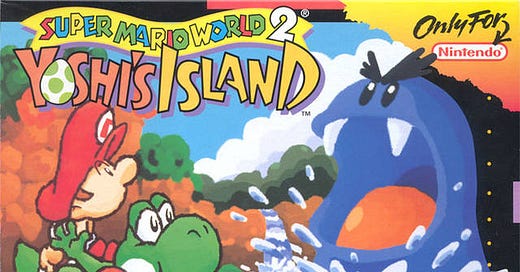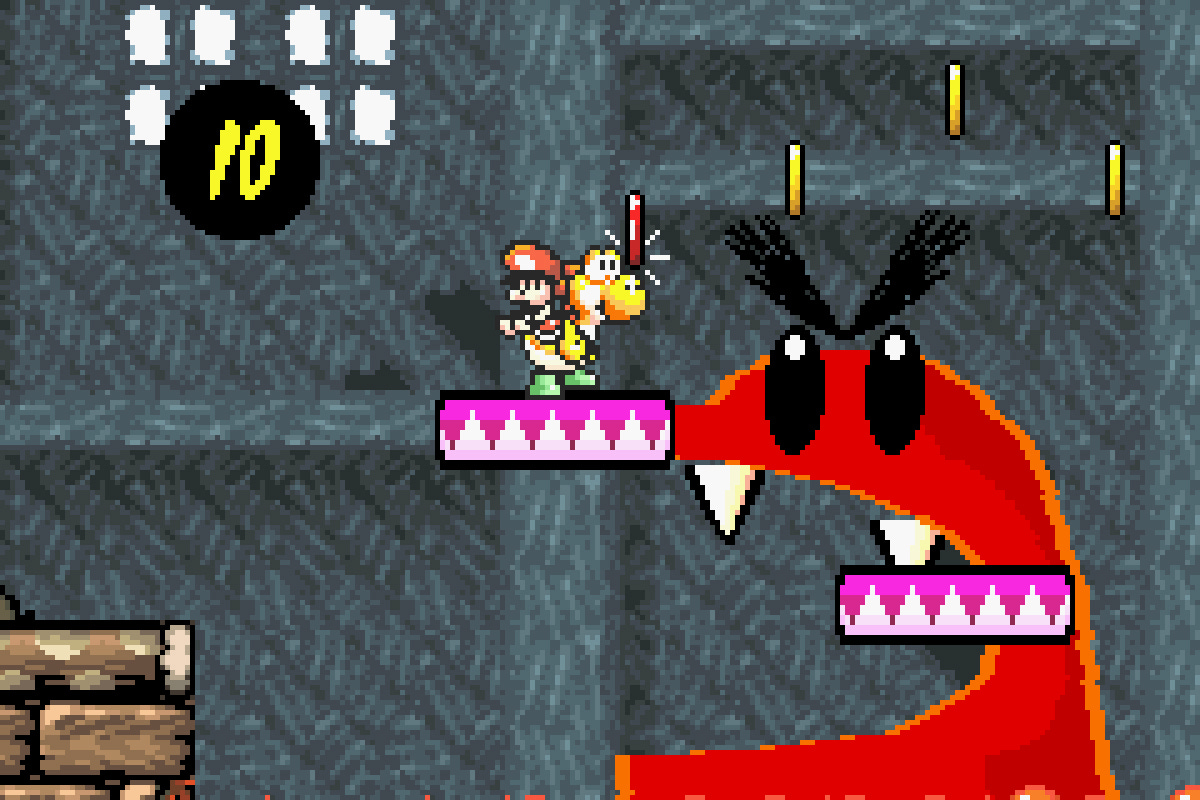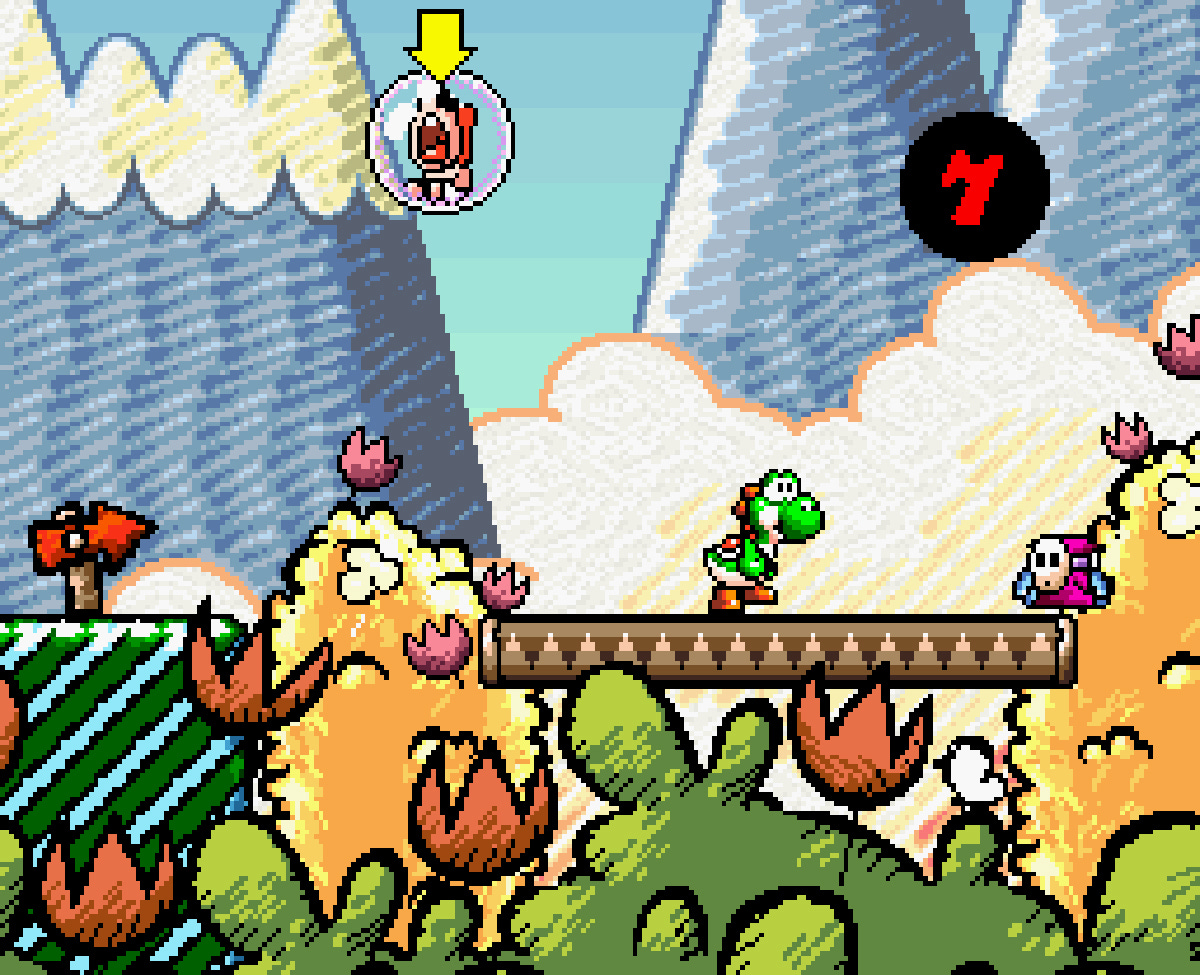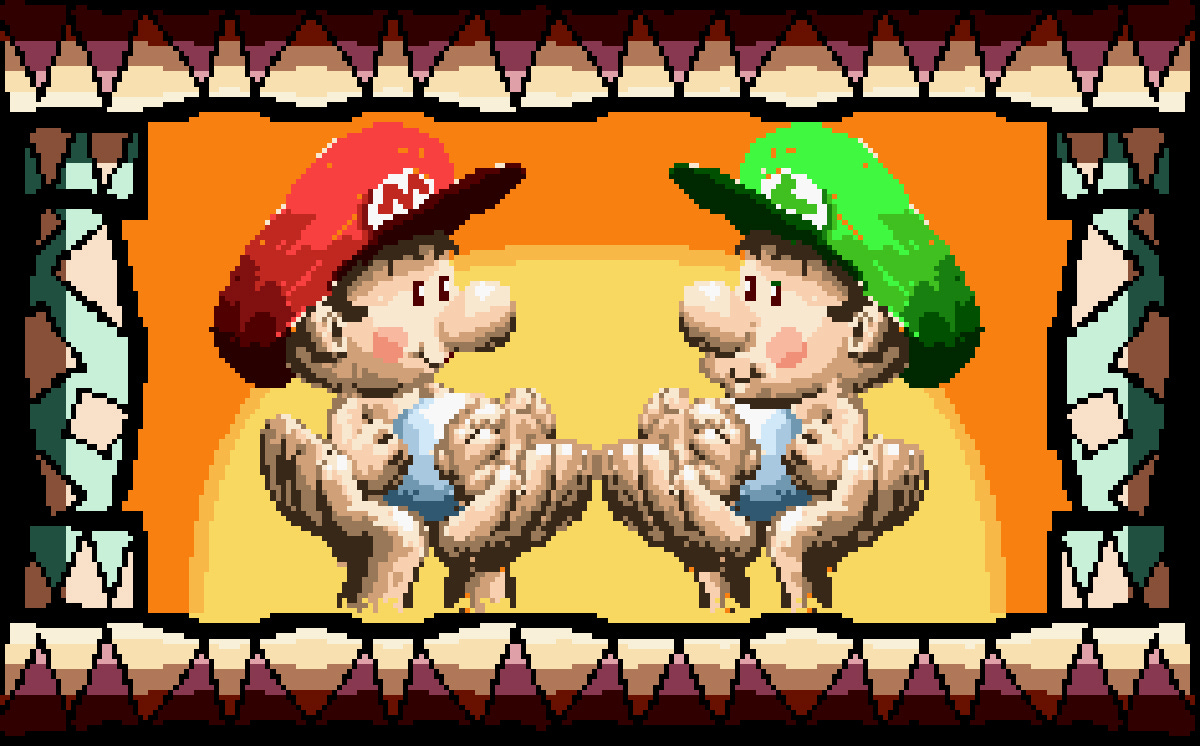Super Mario World 2: Yoshi's Island is One of Nintendo's Greatest Gifts to Mankind
Nearly 30 years later...
Sonoran Videogame Society is a Substack dedicated to playing and exploring video games with friends like you. Some posts are free, some are for paid subscribers only. Don’t forget to sign up here. Thanks for reading!
Super Mario World 2: Yoshi's Island is among the best 2D platformers ever made. This not an opinion up for debate. This is gospel.
Consider its colorful storybook landscapes, an emphasis on collecting/exploring over traditional platforming, inspired Yoshi moves like throwing eggs and hovering, hidden surprises around every corner. Unlike future Yoshi games, there's not a moment wasted, not a single level that doesn't feature a new idea or gimmick. Yoshi's Island brims with effortless, overwhelming creativity.
Before Yoshi's Island grew into the heralded elder statesman that it is today, the game was just another title in the ever-expanding Mario series. Super Mario: Yoshi Island debuted in Japan on August 5th, 1995. No, I didn't leave out "World 2" from the Japanese title. Unlike America and Europe, Yoshi's Island released in Japan without any connection to Super Mario World and was essentially branded as a Mario side-story.
Positioning Yoshi's Island as not part of the mainline Mario series makes complete sense. While both Mario and Yoshi games hail from the platforming genre, both take wildly different approaches. The original 2D Mario games – Mario Bros. 1-3 and Super Mario World – are about getting from one end of the level to the other without dying as quickly as possible. Sure, there are rewards for slowing down - bricks to hit, coins to gather, Goombas to smash – but there's also a timer that continuously counts down. Play and have fun, but watch the clock.
Yoshi's Island and future Yoshi platformers opt for a more methodical approach. You can explore each stage's nooks and crannies at your leisure. Collectibles like sunflowers, red coins, and stars give replayability to each stage. Yoshi's mechanics fit the more relaxed pace of the game as well. Instead of donning a cape or a Tanooki suit and flying across the level, Yoshi can propel upwards with his feet for a brief amount of time before his supple frame brings him back down to earth. Instead of a fire flower to consume his enemies with flames, Yoshi swallows Shy Guys and other adorable jerks, making them into eggs. These eggs can then be aimed and launched at enemies, items, or hidden secrets.
By not including a named connection to Super Mario World, Nintendo allowed Super Mario: Yoshi's Island to exist as its own unique creation in Japan. Yes, they connected the game to Mario because, well, Mario's in the game and Yoshi's Island was the first Yoshi-style platformer at the time. But they clearly wanted Yoshi's Island to stand apart from their main franchise.
Nintendo of America and Nintendo of Europe took the opposite approach. Super Mario World was a massive success, and by gar, they were going to capitalize on it. Super Mario World 2: Yoshi's Island was released on October 4th, 1995 in the United States and October 6th, 1995 in Europe.
Yoshi's Island had the misfortune of coming out at a very weird time for Nintendo in America. The just-released Virtual Boy was sinking fast. The PlayStation – originally a joint venture between Sony and Nintendo - had just launched and was extremely successful right out of the gate. Nintendo's misguided "Play it Loud!" ads were also in full swing. The latter in particular did Yoshi's Island no favors. Ostensibly created to counter Sega's aggressive marketing towards teenagers, this egregious ad campaign presented beloved classics like Earthbound, Kirby Super Star, and yes, Yoshi's Island as juvenile titles for young teen boys. Not Nintendo of America's finest hour.
Let's suppose you were a teenage boy (or a teenage boy's parent) who bought into the disgusting hype for Yoshi's Island. Imagine your surprise when you were greeted by the sickeningly sweet nursery rhyme at the beginning of the game. Mario's an adorable baby being carried by a stork to his parents (what, no sex in Mario's world?!). The Yoshis are outrageously cute dinosaurs. Each level looks like your young sister's Beanie Baby coloring books. Where's the barf? Where's the poop?! Oh no! Nintendo lied to you!
When Yoshi's Island came out in late 1995, I was not a teenager who thought barf and poop were cool and/or funny. I was a ten-year-old who distrusted the game's overly cutesy style. I didn't know why the game was called Super Mario World 2 if you didn't actually control Mario. While I was more of a Sonic fan than a Mario fan at the time anyway, I had played and loved all mainline Mario games up to that point. Nevertheless, I stayed away from Yoshi's Island for years afterwards (I didn't even rent it, what the heck was my problem?) before finally picking up the game in middle school. Yoshi's Island hooked me instantly and continues to reward upon repeat plays, nearly thirty years later.
The game is not without its faults, though. Everybody likes to talk about baby Mario's obnoxious cry, and yes, that wail does grate quickly (that was definitely the point). The controls assign 'B' to jump and 'A' to throwing eggs, and if you've ever played video games where jump is almost universally assigned to 'A', you know this feels weird. Not weird enough to stop playing, but certainly an odd choice. About ten years ago, I did a 100% clear for the first time ever – and the last. The amount of time spent getting every red coin, flower, and star was too much. The reward? A single extra stage, a bonus game you can play any time you want, and a star next to the title screen. Not enough.
No game is perfect, that is true. Yoshi's Island comes darn close. In a time where polygons and prerendered visuals captivated young eyes everywhere, Yoshi's Island leaned into its crayon storybook aesthetic without shame or apology. In a time where gore and mature themes were becoming more commonplace, Yoshi's Island featured a story about a cute dinosaur returning a baby to his parents. Most importantly, in a time where the platforming genre had been used and abused ever since Super Mario Bros. popularized it a decade prior, Yoshi's Island breathed life into an increasingly stale formula. The game remains one of Nintendo's finest masterpieces and proof that video games are, indeed, art.











Good review.
Unlike you, I DID rent this one when it came out. I recall playing it a lot that weekend, beating it, and thinking, "Really solid game, but not as good as Super Mario World," and then not thinking much about it for a good 15-20 years, until I realized that it was remembered as a cult classic.
I wish I could divorce myself from the nostalgia for Super Mario World, but I don't think I can. The launch of the SNES was the most excited I've ever been for anything in the world of video games, before or since. So while I can recognize, intellectually, the shortcomings of some examples of SMW's level design and its possibly too-easy difficulty, I'm still not able to experience Yoshi's Island as the better game. But how differently would I feel if their release dates were reversed?
I think your criticism of Yoshi's Island's 100% mechanic is valid. I've still never done this, I've found it annoying when I tried, and I didn't even attempt it when I rented it. Contrast this with "mastery" in Super Mario World, which equates to unlocking all 96 gates. Maybe too easy, but a much more reasonable and interesting objective, and the reward is much more tangible, in terms of opening up the world map.
Maybe these days we see world maps as kind of a gimmick. What's the difference if I just pick the level from a menu? Is time spent moving around the map just boring padding? Etc.
But I think (admittedly with rose-tinted glasses) SMW probably did world maps better than any other 2D Mario game, including Mario Wonder. I recall really missing it in Yoshi's Island. It made the game feel smaller to me. SMW's map really conveys a sense of exploration, and I'm someone that has always enjoyed that in games.
Rented this from Blockbuster back in the day. This had to be around the time I got my PlayStation so this game had to have been the last new game I played for the SNES. It’s lots of fun, the game stands on its own apart from Super Mario World and was really a showcase for the power of Nintendo’s 16-bit console. It really looked like a game that should be running on more powerful hardware.
Oddly enough when I finally bought a copy of this a few years back it still had the Blockbuster sticker on it. This made me wonder if this was the very same copy I rented back in the day, however unlikely that would be.